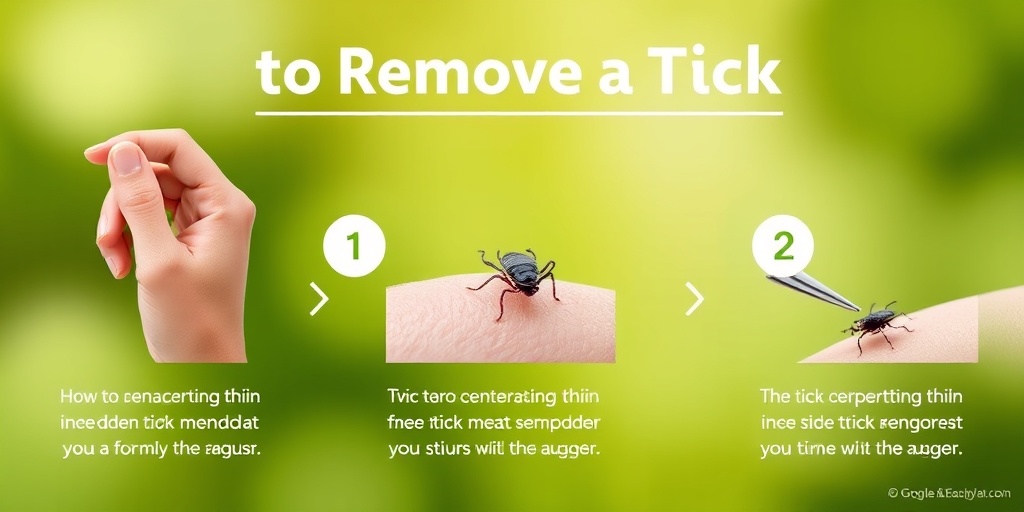What Are Ticks? 🕷️
Ticks are small, blood-sucking arachnids that belong to the order Parasitiformes. They are often found in wooded or grassy areas and are notorious for their role as parasites, feeding on the blood of mammals, birds, reptiles, and amphibians. Ticks are not insects; they are more closely related to spiders and scorpions. Understanding ticks is crucial, especially when it comes to tick removal and preventing tick-borne diseases.
Types of Ticks
There are several species of ticks, but the most common ones include:
- Deer Tick (Ixodes scapularis): Known for transmitting Lyme disease.
- Dog Tick (Dermacentor variabilis): Commonly found on pets and can carry diseases like Rocky Mountain spotted fever.
- Brown Dog Tick (Rhipicephalus sanguineus): Primarily infests dogs and can transmit various pathogens.
- American Dog Tick (Dermacentor variabilis): Found in the eastern United States and can also transmit diseases.
Life Cycle of Ticks
The life cycle of a tick consists of four stages: egg, larva, nymph, and adult. Each stage requires a blood meal to progress to the next. Ticks can be active year-round, but they are most prevalent during warmer months. Understanding their life cycle can help in preventing infestations and knowing when to be vigilant about tick removal.
Tick-Borne Diseases 🦠
Ticks are vectors for a variety of diseases that can affect both humans and animals. These diseases can range from mild to severe, and in some cases, they can even be life-threatening. Here are some of the most common tick-borne diseases:
1. Lyme Disease
Lyme disease is perhaps the most well-known tick-borne illness. It is caused by the bacterium Borrelia burgdorferi and is primarily transmitted by the deer tick. Early symptoms include fever, headache, fatigue, and a characteristic skin rash known as erythema migrans. If left untreated, Lyme disease can lead to more severe health issues, including joint pain and neurological problems.
2. Rocky Mountain Spotted Fever
This disease is caused by the bacterium Rickettsia rickettsii and is transmitted by dog ticks. Symptoms typically appear within 2 to 14 days after a tick bite and may include fever, rash, and muscle pain. If not treated promptly, Rocky Mountain spotted fever can be fatal.
3. Anaplasmosis
Anaplasmosis is caused by the bacterium Anaplasma phagocytophilum and is transmitted by the deer tick. Symptoms can include fever, chills, headache, and muscle aches. Early diagnosis and treatment are essential to prevent complications.
4. Babesiosis
This disease is caused by microscopic parasites that infect red blood cells and is transmitted by the black-legged tick. Symptoms can range from mild to severe and may include fever, chills, and fatigue. In some cases, babesiosis can lead to serious complications, especially in individuals with weakened immune systems.
Preventing Tick-Borne Diseases
Prevention is key when it comes to tick-borne diseases. Here are some effective strategies:
- Use Tick Repellents: Apply insect repellent containing DEET on exposed skin and clothing.
- Wear Protective Clothing: Long sleeves and pants can help reduce skin exposure.
- Check for Ticks: After spending time outdoors, thoroughly check yourself, your pets, and your clothing for ticks.
- Tick Removal Tools: Keep a tick removal tool or tweezers handy for safe and effective tick removal.
If you find a tick on yourself or your pet, it’s essential to remove it promptly and correctly. For more information on tick removal techniques and health-related queries, consider visiting Yesil Health AI for evidence-based answers.
By understanding ticks and the diseases they carry, you can take proactive steps to protect yourself and your loved ones. Stay informed, stay safe, and enjoy the great outdoors! 🌳

Signs of Tick Infestation
Ticks are more than just a nuisance; they can pose serious health risks to both humans and pets. Recognizing the signs of a tick infestation early can help you take action before it becomes a larger problem. Here are some common indicators to watch for:
1. Frequent Tick Bites
If you or your pets are experiencing frequent tick bites, it’s a clear sign that ticks are present in your environment. Pay attention to any unusual itching or irritation on your skin or your pet’s fur. 🐾
2. Visible Ticks
One of the most obvious signs of a tick infestation is the presence of ticks themselves. These small, blood-sucking parasites can often be found on your skin, clothing, or your pet’s fur. Ticks can vary in size, but they are typically small and can be as tiny as a poppy seed or as large as a grape when engorged with blood.
3. Tick Bites on Pets
If you notice your dog or cat scratching excessively, it may be due to tick bites. Look for signs of irritation or inflammation on their skin, especially around the ears, neck, and between the toes. 🐶🐱
4. Changes in Behavior
Ticks can cause discomfort and illness in pets, leading to changes in behavior. If your pet seems lethargic, refuses to eat, or is unusually irritable, it may be worth checking for ticks.
5. Tick-Infested Areas
Ticks thrive in certain environments, particularly in wooded or grassy areas. If you’ve been in such locations and notice any of the above signs, it’s crucial to check yourself and your pets for ticks after returning home.
6. Symptoms of Tick-Borne Diseases
In some cases, ticks can transmit diseases such as Lyme disease, Rocky Mountain spotted fever, and more. Symptoms of these diseases can include:
- Fever and chills
- Fatigue
- Muscle and joint pain
- Rash (in some cases)
If you or your pet exhibit these symptoms after a tick bite, seek medical attention promptly.
How to Remove a Tick
Removing a tick promptly and correctly is essential to minimize the risk of disease transmission. Here’s a step-by-step guide on how to safely remove a tick:
1. Gather Your Supplies
Before you begin, make sure you have the following items:
- Tick removal tool (such as tweezers or a specialized tick removal tool)
- Gloves (to protect your hands)
- Antiseptic (for cleaning the bite area)
- Container (to store the tick for identification)
2. Wear Gloves
Put on gloves to prevent any potential transmission of diseases. This is especially important if you’re removing a tick from a pet.
3. Grasp the Tick
Using your tick removal tool or tweezers, grasp the tick as close to the skin’s surface as possible. Be careful not to pinch the skin. 🦠
4. Pull Upward Steadily
With a steady motion, pull upward without twisting or jerking. Twisting can cause the mouth-parts to break off and remain in the skin, which can lead to infection.
5. Clean the Area
Once the tick is removed, clean the bite area and your hands with antiseptic. This helps prevent any infection.
6. Dispose of the Tick
Place the tick in a sealed container or a zip-lock bag. You may want to keep it for a few weeks in case you develop symptoms, as it can help your healthcare provider identify the type of tick and any potential diseases.
7. Monitor for Symptoms
Keep an eye on the bite area for signs of infection, such as redness, swelling, or pus. Also, be aware of any symptoms of tick-borne diseases that may develop in the following weeks.
By following these steps, you can effectively remove a tick and reduce the risk of complications. Remember, if you’re unsure about the removal process or if you notice any concerning symptoms, don’t hesitate to consult a healthcare professional. 🩺

Tools for Tick Removal
When it comes to tick removal, having the right tools can make all the difference. Ticks can carry diseases, so it’s crucial to remove them properly and promptly. Here’s a rundown of the most effective tools you can use for tick removal, whether for yourself, your dog, or your cat. 🐾
1. Tick Removal Tweezers
One of the most popular tools for tick removal is a pair of specialized tick removal tweezers. These tweezers are designed to grasp the tick as close to the skin as possible, allowing for a safe and effective removal. Here’s how to use them:
- Grip the tick: Use the tweezers to grab the tick as close to the skin’s surface as possible.
- Pull upward: Apply steady, even pressure to pull the tick straight out without twisting or jerking.
- Clean the area: After removal, clean the bite area and your hands with rubbing alcohol or soap and water.
2. Tick Removal Tools for Dogs and Cats
If you have pets, investing in a tick removal tool for dogs or tick removal tool for cats is essential. These tools often come in the form of a small, curved device that allows you to slide under the tick and lift it out. Here’s how to use them:
- Slide the tool: Gently slide the tool under the tick.
- Lift and remove: Lift the tool to remove the tick without squeezing its body.
- Dispose properly: Dispose of the tick in a sealed bag or container.
3. Tick Removal Kits
For those who want to be fully prepared, a tick removal kit can be a great investment. These kits typically include tweezers, a magnifying glass, antiseptic wipes, and a container for tick disposal. Having a kit on hand ensures you’re ready to act quickly if you find a tick on yourself or your pet.
4. Home Remedies and Alternatives
While specialized tools are recommended, some people consider home remedies for tick removal. However, these methods can be risky and may not be effective. Common home remedies include:
- Petroleum jelly: Some suggest applying petroleum jelly to suffocate the tick, but this can lead to the tick regurgitating its contents into the host.
- Alcohol: Dousing the tick in alcohol may cause it to detach, but it can also lead to infection.
It’s best to stick with proven tools and methods for safe and effective tick removal. 🛠️
Aftercare for Tick Removal
After successfully removing a tick, proper aftercare is essential to prevent infection and monitor for any potential symptoms. Here’s what you need to do:
1. Clean the Bite Area
Immediately after removing the tick, clean the bite area thoroughly. Use soap and water or an antiseptic wipe to ensure that any bacteria introduced during the removal process are eliminated. This step is crucial in preventing infection. 🧼
2. Monitor for Symptoms
Keep an eye on the bite area for the next few weeks. Look for signs of infection, such as:
- Redness or swelling: A small amount of redness is normal, but if it spreads, consult a healthcare professional.
- Pain or tenderness: If the area becomes increasingly painful, seek medical advice.
- Flu-like symptoms: Symptoms such as fever, chills, or fatigue may indicate a tick-borne illness.
3. Dispose of the Tick Properly
After removal, it’s important to dispose of the tick safely. Place it in a sealed bag or container and keep it in the freezer. This way, if you develop symptoms later, you can show the tick to your healthcare provider for identification.
4. Seek Medical Attention if Necessary
If you experience any unusual symptoms after a tick bite, don’t hesitate to consult a healthcare professional. Early detection and treatment of tick-borne diseases can significantly improve outcomes.
By following these aftercare steps, you can ensure a smooth recovery and minimize the risk of complications from a tick bite. Remember, prevention is key, so consider using tick repellents and checking for ticks regularly, especially after outdoor activities. 🌳

Preventing Tick Bites
Ticks are more than just a nuisance; they can carry serious diseases that affect both humans and pets. Understanding how to prevent tick bites is essential for maintaining your health and the well-being of your furry friends. Here are some effective strategies to keep ticks at bay:
1. Dress Appropriately for Outdoor Activities
When venturing into wooded or grassy areas, wearing the right clothing can significantly reduce your risk of tick bites. Consider the following:
- Wear long sleeves and pants: Tucking your pants into your socks can create a barrier that makes it harder for ticks to reach your skin.
- Choose light-colored clothing: This makes it easier to spot ticks before they attach.
- Use tick-repellent clothing: Some outdoor gear is treated with permethrin, a chemical that repels ticks.
2. Use Tick Repellents
Applying a tick repellent can provide an extra layer of protection. Look for products that contain:
- DEET: A common and effective ingredient in many insect repellents.
- Picaridin: An alternative to DEET that is also effective against ticks.
- Oil of lemon eucalyptus: A natural option that can repel ticks.
Always follow the instructions on the product label for safe and effective use. 🦟
3. Create a Tick-Safe Zone in Your Yard
If you have a yard, maintaining it can help reduce tick populations:
- Keep grass trimmed: Regular mowing can prevent ticks from thriving.
- Remove leaf litter: Ticks love to hide in damp, dark areas.
- Use wood chips or gravel: Create barriers between wooded areas and your lawn to deter ticks.
4. Regularly Check for Ticks
After spending time outdoors, it’s crucial to check yourself, your children, and your pets for ticks. Pay special attention to:
- Behind the ears
- Under the arms
- In the hair
- Between the legs
- Around the waist
Removing ticks promptly can help prevent disease transmission. If you find a tick, use a tick removal tool or tweezers to remove it safely.
When to Seek Medical Help
While many tick bites are harmless, some can lead to serious health issues. Knowing when to seek medical help is crucial for your safety. Here are some signs and symptoms to watch for:
1. Signs of Infection
If you notice any of the following symptoms after a tick bite, it’s essential to consult a healthcare professional:
- Redness or swelling: If the bite area becomes increasingly red or swollen, it may indicate an infection.
- Pus or drainage: Any discharge from the bite site should be evaluated by a doctor.
2. Flu-like Symptoms
Ticks can transmit diseases such as Lyme disease and Rocky Mountain spotted fever. If you experience:
- Fever or chills
- Fatigue
- Muscle or joint aches
- Headaches
- Rash: Especially a bullseye rash, which is characteristic of Lyme disease.
These symptoms may appear days to weeks after a tick bite, so it’s important to stay vigilant. 🩺
3. Unusual Symptoms
In some cases, tick bites can lead to more severe reactions. Seek immediate medical attention if you experience:
- Difficulty breathing
- Swelling of the face or throat
- Confusion or disorientation
These symptoms could indicate a severe allergic reaction or a serious tick-borne illness.
Being proactive about tick prevention and knowing when to seek medical help can significantly reduce your risk of tick-borne diseases. Stay safe and enjoy the outdoors! 🌳

Frequently Asked Questions about Tick Removal
What is the best method for tick removal?
The best method for tick removal involves using a specialized tick removal tool or fine-tipped tweezers. Grasp the tick as close to the skin’s surface as possible and pull upward with steady, even pressure. Avoid twisting or jerking, as this can cause parts of the tick to break off and remain in the skin.
Can I remove a tick at home?
Yes, you can safely remove a tick at home using a tick removal kit or tweezers. Ensure you have the right tools and follow proper techniques to minimize the risk of infection.
How do I remove a tick from my dog or cat?
To remove a tick from your pet, use a tick removal tool for dogs or tick removal tweezers. Follow the same procedure as you would for humans, ensuring to grasp the tick close to the skin and pull straight out.
What should I do after removing a tick?
After tick removal, clean the bite area and your hands with rubbing alcohol, an iodine scrub, or soap and water. Monitor the area for signs of infection or rash, and consult a healthcare professional if you notice any unusual symptoms.
Where can I find tick removal tools near me?
You can find tick removal tools at local pharmacies, pet stores, or online retailers. Look for a tick removal kit that includes all necessary tools for safe removal.
Are there any risks associated with tick removal?
Yes, improper tick removal can lead to infection or the transmission of diseases such as Lyme disease. It’s crucial to use the correct technique and tools to minimize these risks.
How can I prevent ticks from attaching to my pets?
To prevent ticks on your pets, consider using tick prevention products such as topical treatments, collars, or oral medications. Regularly check your pets for ticks, especially after outdoor activities.
What are the signs of tick-borne diseases?
Signs of tick-borne diseases can include fever, rash, fatigue, and joint pain. If you or your pet exhibit these symptoms after a tick bite, seek medical attention promptly.




